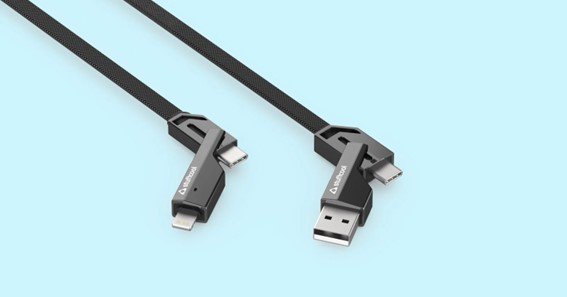With advancements in technology, the transition from traditional USB-A to the more versatile USB Type-C has become a key trend in electronic devices. One of the most commonly used accessories for bridging this gap is the USB-A to USB Type-C cable, which connects older devices with USB-A ports to newer devices featuring USB Type-C inputs.
In this blog, we will explore the features, uses, and benefits of the USB-A to USB-C cable, and answer some frequently asked questions.
What Is A USB-A To USB Type-C Cable?
A USB-A to USB Type-C cable is a hybrid solution designed to connect devices with older USB-A ports, such as traditional computers or chargers, to newer devices equipped with USB-C ports, like smartphones, tablets, and laptops.
USB-A connectors are rectangular, while USB-C connectors are smaller, oval-shaped, and reversible, making them easier to use. This cable offers compatibility between devices across generations, ensuring seamless data transfer and charging across a wide range of devices.
Key Features Of USB-A To USB Type-C Cable
- Universal Compatibility: It bridges the gap between older USB-A devices and newer USB-C gadgets.
- Reversible USB-C Connector: The USB-C end is reversible, which means you can plug it in any orientation, adding convenience.
- Faster Charging and Data Transfer: Depending on the version, these cables support rapid data transfer speeds (up to 10 Gbps) and power delivery, making them ideal for fast charging and syncing large files like videos and photos.
- Durability: USB-A to USB-C cables are often built with durable materials to withstand wear and tear from frequent use, ensuring longevity.
Uses Of USB-A To USB Type-C Cable
- Charging: These cables are perfect for charging newer USB-C devices from older USB-A chargers, allowing you to keep using your old charging bricks.
- Data Transfer: The cable allows you to transfer data between older devices (like a desktop with a USB-A port) and modern smartphones, tablets, or external drives with USB-C.
- Compatibility Across Devices: Whether it’s for syncing data between a computer and a phone or using a USB-A power bank to charge a USB-C device, this cable is indispensable for compatibility across generations of technology.
Benefits Of USB-A To USB Type-C Cables
- Backward Compatibility: It maintains compatibility with older USB standards, allowing you to use the same cable with different generations of devices.
- Power Delivery: USB-A to USB-C cables, particularly those that support USB 3.1 and later, offer high-speed charging, capable of delivering up to 100W, enough for smartphones, tablets, and even some laptops.
- High-Speed Data Transfer: With support for speeds up to 10 Gbps, it is perfect for transferring large files between devices.
FAQ
-
What is the difference between USB-A and USB-C?
USB-A is the traditional rectangular connector found in older devices, while USB-C is a smaller, reversible connector that supports higher power and faster data transfer.
-
Can I use a USB-A to USB-C cable for fast charging?
Yes, depending on the specifications of the cable, a USB-A to USB-C cable can support fast charging, especially with USB 3.0 or later standards.
-
Is a USB-A to USB-C cable compatible with all USB-C devices?
Yes, this cable is designed to connect USB-A chargers or ports to USB-C devices, making it universally compatible for charging and data transfer.
-
Can I transfer data using a USB-A to USB-C cable?
Yes, these cables are capable of transferring data between devices, with speeds varying depending on the USB standard (USB 2.0, 3.0, etc.).
-
Do USB-A to USB-C cables support video output?
No, most USB-A to USB-C cables are designed for data transfer and charging but not for video output. USB-C cables on their own (without USB-A) typically support video output through DisplayPort or HDMI.
By choosing the right USB-A to USB Type-C cable, you ensure seamless compatibility between devices and experience faster charging and data transfer speeds across your gadgets.










